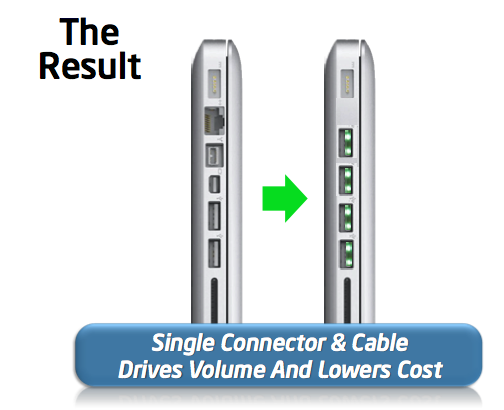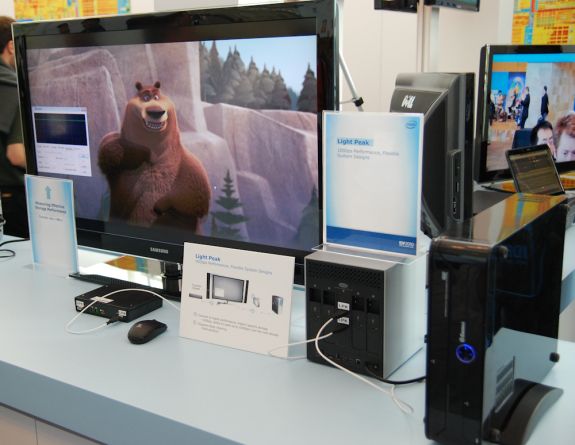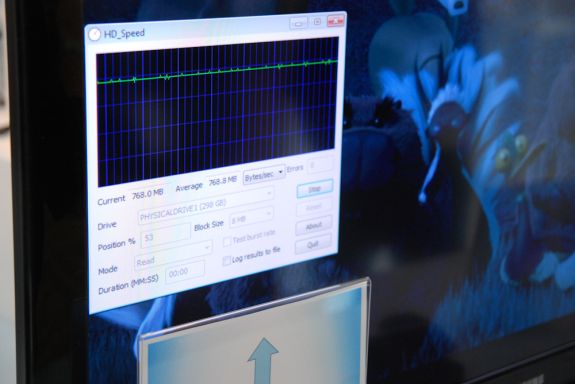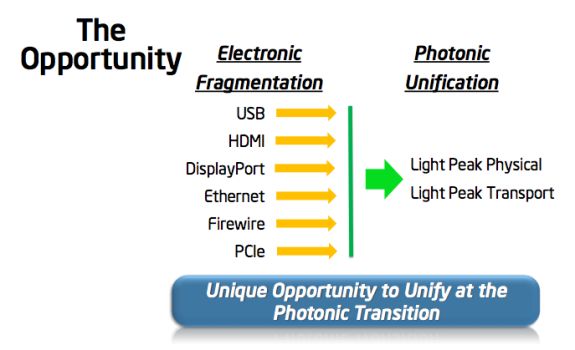Intel Light Peak - Lighting up 10 Gbps links in 2011
by Brian Klug on September 16, 2010 3:40 PM EST- Posted in
- Trade Shows
- Intel
- LightPeak
The second demo involved a desktop PC with Light Peak connecting to a modified LaCie 4big Quadra, daisy chained to another display with a built in HDMI adapter. Note that Light Peak supports daisy chaining as this demo was connected, but also supports a star topology like USB does.
At the far left on the TV was the total bitrate of the storage system, which showed a solid 768.8 megabytes/s of throughput. That's 6.15 gigabits per second of throughput. Obviously the video must have been uncompressed to achieve such high bitrate, but the display itself was only 1080P.
Both of these demos really show how close Intel is to finalizing Light Peak for consumer consumption, and how closely they've been working with partners like Western Digital and Avid for having devices ready eventually.
Obviously USB will live on for years, and USB 3.0 still isn't completely ubiquitous, but the allure of using a single connection and cable for everything sometime in the future is hard to pass up.
The Tech
I spoke with Jason Ziller - Intel's director of Optical I/O planning - about what's left for Light Peak before we can all start enjoying one superfast desktop connection. Availability was originally slated to be Q4 2010, that date has now slipped to sometime inside 2011.

Remember that USB-like port? It actually is USB, but that's only for ease of testing until Light Peak's new connector is finalized. The connector won't look like USB, and obviously will have something unique to mitigate both alignment and potential damage to the interface. Intel isn't ready to say what this looks like, but obviously the connector will be subject to the same kind of scrutiny that USB was for durability and consumer friendliness.
Light Peak isn't a protocol, but instead simply provides a new physical layer for existing connector protocols. Traffic like DVI-D, HDMI, USB, and audio can all coexist across Light Peak.
Intel didn't need to use WDM (Wavelength Division Multiplexing) to achieve 10 Gbps as demonstrated, and maintains that although WDM could be used in the future to increase bandwidth, there are other ways to scale to 100 Gbps. Currently Light Peak is 100 meters capable, though the actual product will be 50 meters of distance. Cables have sufficiently small bend radius that they can be wrapped in a knot or around a pencil without the connection losing connectivity, and up to 7 devices can be daisy chained.
Interestingly, Intel is using an 850 nm wavelength laser for the system, and (unsurprisingly) multimode fiber. Data is bidirectional across the interface as well. 850 nm is a rather interesting choice, as it's still subject to class 1 eye safety limits (just above -4 dBm), but moreso because it was the wavelength used in some of the world's very first long haul fiber optic networks.
Intel's silicon photonics remain a separate project from Light Peak, as Light Peak uses VCSEL laser diodes. The long term vision is to eventually bring the two together in a much broader scope to bridge datacenters together instead of just desktops.
There's a lot of potential for the future of desktop optical interfaces - Intel just has to deliver them. Let's hope it happens in 2011 as promised!













59 Comments
View All Comments
digitaldreamer - Thursday, September 16, 2010 - link
What's the story on ATA? Or, is that assumed to be included as part of the other protocols?MAJ
digitaldreamer - Thursday, September 16, 2010 - link
And, what protocol was used for the external hard drive? USB?MAJ
<wishing for a EDIT option>
jordanclock - Friday, September 17, 2010 - link
ATA is in. USB is in. Any protocol is in. It's up to the device to determine the protocol. You could have external drives using SCSI, USB, or something of their own proprietary design. That's the biggest point of LP: It doesn't care how you organize your bits, it just wants to get them there fast.Mike1111 - Thursday, September 16, 2010 - link
All the LightPeak prototypes seem to have two optical fibers. Wouldn't that mean 20 Gbit/s in each direction?SimKill - Thursday, September 16, 2010 - link
I think its bidirectional, i.e. one for Transmit and one for Receive.So each line would still have only 10Gbps
J_Tarasovic - Thursday, September 16, 2010 - link
Nice work. I am pretty excited about the technology. Still waiting on some SSD news though.DigitalFreak - Thursday, September 16, 2010 - link
I was beginning to think someone from DailyTech snuck an article in. :0)pesos - Thursday, September 16, 2010 - link
could this finally boot expensive fiber channel and provide an inexpensive method for enterprise SAN connections at a far lower cost than FC or 10gbe iscsi?AnnonymousCoward - Thursday, September 16, 2010 - link
The goals that this is set to achieve are:1. 300ft point-to-point cables
2. One cable type for multiple protocols
So...who cares? Repeaters or wireless can already give us cables as long as we want. And what's the point of 1 cable type for all devices? This won't reduce the number of cables involved, it just means 1 type. I don't care what type connects my PC to my monitor, do you? I also think Intel's claim that this lowers cost is bunk, since this means you'll need Light Peak bridges all over the place to convert to our established protocols. That also means that every component would need to adopt it, which won't happen anytime soon.
And why get light involved? If you want a single cable with tons of bandwidth, just use multi-lane PCIe. That'd probably be a lot cheaper, too. USB3 is like 1 lane PCIe2, and they probably could have made it more lanes, but that would increase the cost for unnecessary bandwidth.
I'm with ya, JoKeRr. Apple's pushing it cuz it's "oooo, light" and their next big idiotic marketing thing.
Best Buy charges $230 for a 6.6ft HDMI cable. Who wants to pay $10,000 for a 300ft optical?
zodiacfml - Thursday, September 16, 2010 - link
Aside for having one type of cable to most devices, fiber optics is just the way to go for more bandwidth rather than making more copper lines/wires.One thing I would agree on is this won't make it mainstream in the near future. USB 3.0 is hugely fast for almost all devices and provides electricity to a device, yet I could see Light Peak being used for display connections, HD cameras, external drives in one or two years.